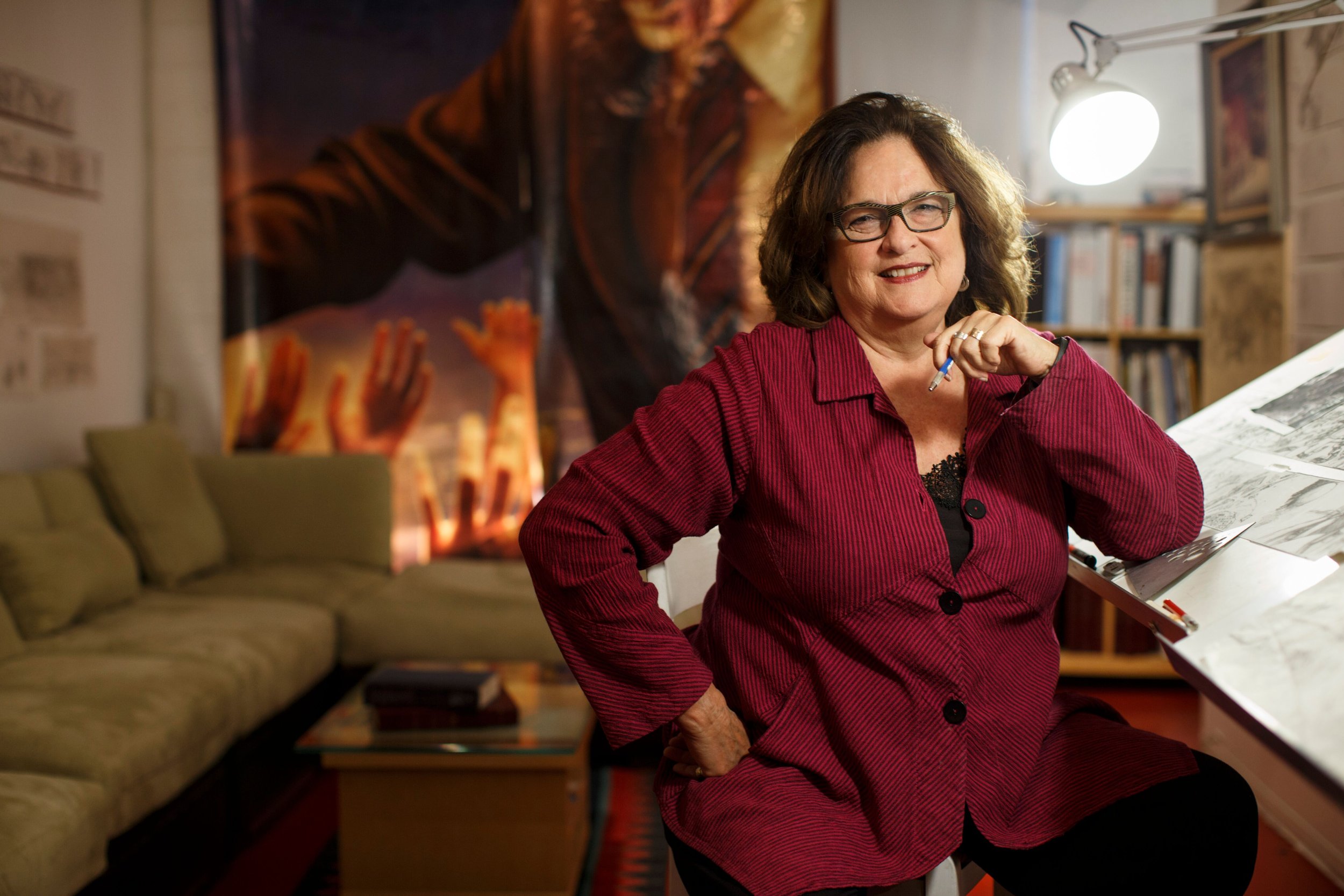
La Memoria de la Tierra: UCLA

Creating Judy Baca's "La Memoria de la Tierra: UCLA” mural
Creating Judy Baca's "La Memoria de la Tierra: UCLA" mural
The ask was bold and befitting a Bruin like professor and artist Judith Baca. Depict the history, present and future of UCLA and the land where it resides, in a mural.
I'm always looking for the story that has not been told. - Judy Baca
For the past 100 years, UCLA has stood on this land and served the young people of Southern California. The culmination of plans to commemorate this centennial celebration led to the artist, activist, and professor Judy Baca. Between Baca, her team at Social and Public Art Resource Center, and the Digital Mural Lab, a mural has been created that showcases a vision of the past, present, and future that collide into an ongoing conversation honoring the stories that must be told to facilitate the creation of a more equal and prosperous future for all. The home of the mural is on Ackerman Union — the central location of the Associated Students of the University of California, Los Angeles. Judy Baca, ASUCLA, and SPARC are united in presenting a piece of art that can create conversations and support a changing world in pursuit of social justice, equity, and equality.
The mural is composed of three glass panels made in an innovative process that is evolving both the art of mural creation and the ability to preserve a mural in a way that goes beyond methods of traditional paint. Minerals of all colors are cultivated to meld into glass that transform a digitally created mural into one that can be physically manufactured and displayed.
The first of the three panels focuses on the land of the Westwood, Los Angeles neighborhood that UCLA is built upon. The depiction is of a land before industrialization where the original flora, fauna, and peoples exist in a time before great change. Upon this topography is an architectural line drawing of Royce Hall to foreshadow the changes to come to this land. Both the past and present exist within this panel to display the Indigenous concepts of the land containing, simultaneously in time, all memory.
The second panel contains figures that Baca and her team have chosen to represent a new narrative of stories that center around women who have made an impact.
The third panel depicts an idea of the university of the future that goes beyond physical structures. This evolved form of the university would go out to all communities and arenas to provide education and guidance to a continuously changing world.
The Land, Memory, and Rivers
The first thing I thought: It had to be conscious of the environment and who was here first.
What was the spiritual consequence? ... Of the original animals being there and no longer there and the original people and so forth. - Judy Baca
The land and memory are central to a series of Judy Baca works, and the current UCLA mural begins with the land before construction and industrial planning. For a century, UCLA has stood on this land containing all the memory of the past, but before a river ran through the land on which buildings now stand. Rivers have been central to Baca's work and can be found in both this latest mural and in the decades of work done at The Great Wall of Los Angeles. The Great Wall of Los Angeles is not only the longest mural in the world, but the flood control channel in which the mural is located was once a river. The first panel of the mural is centered around the land that is now the Westwood neighborhood of Los Angeles with original flora, fauna, and people.
It’s an indigenous notion. I think it probably comes from my own background, my grandmother, who is an indigenous woman and who sort of essentially without really sitting down and schooling me, gave me the notion that everything that ever occurred on the land is recorded there, that somehow it’s present. - Judy Baca
The Past and Present
There are choices that we made at a particular historical moment and that is what I hope people see. - Judy Baca
On April 27, 1965, Martin Luther King Jr. came to UCLA and spoke to thousands on the Civil Rights Movement and the fight for social justice. Decades later, the fight continues. During the creation of this mural, Judy Baca and the artists of SPARC witnessed the national protests and the Black Lives Matter movement ignite within the unknown and tumultuous realities of a global pandemic.
We are making this work in a pandemic. We were making it in the middle of a massive social justice movement in the United States where people were taking to the streets. We were making it in a time in which we were dealing with profound issues of global warming and fires and floods and all kinds of things happening worldwide, all of which were affected by loss, losses of family members, loss of friends — enormously impactful to us in terms of making it. So, we were subject to those changes as we were making the work. In other words, an artist doesn't work independently in the place they are or the time they are living in. They are totally affected by that, as we were in making this work. - Judy Baca
The Trinity and The Figures Around Them
It seemed to me that she should be here. She would become the spirit of that memory and that land. A magnificent young woman who is no longer anonymous. - Judy Baca
Within the middle panel are the dominant figures of the piece. Among them are three individuals that Baca has described as the “trinity” of the mural: Toypurina, Angela Davis, and Dolores Huerta. These three figures were sought after by Baca to be a source of inspiration and stand as “fierce, compassionate, fascinating, and powerful women.” Baca has been on a journey to identify or create a history for a young Gabrielino or Tongva woman in a 19th-century photograph with the only information written being “anonymous Gabrielina nation woman.” Baca has attached the name and story of Toypurina to this once anonymous woman. The story of Toypurina involves the mission San Gabriel and a revolt that was led against the mission in 1785 by Toypurina, a young indigenous woman at the age of 23. Baca connects that this age is that of most of the young students of UCLA and marks them historically as leaders of change
Time and perception have changed, expanded, and evolved the view of these three figures. Angela Davis stands in the mural as a fierce voice for social change even if it comes at a cost.
As time has gone by since the formation of the United Farm Workers Association, Delores Huerta has gained recognition for her central role in the formation of that association as co-founder, her fight for the rights of farmworkers across the nation, and cemented her legacy in the Chicano civil rights movement. Immediately surrounding this trinity is the figure of John Lewis. The civil rights activist, Congressman, and Selma march leader died during the creation of the mural and in the midst of protests and marches against police brutality. California State Senator Maria Elena Durazo is the next largest figure and personal inspiration to Baca as an activist for the rights of janitors, restaurant, and hotel workers.
All remaining figures are of specific and profound note and form a ring around the central trinity.
The University of the Future
We created the rhizomes that go out.
They go to a burning planet, and the edge of the world is on fire and these rhizomes are putting out the fire, so it’s a hopeful view that knowledge and education will change the way that we live and work. - Judy Baca
Horizontally growing from some plants are structures similar to roots called rhizomes. The root holds the plant into the land and the rhizomes support this effort while sprouting to the surface to create a new plant. This new life stems from a common source. This is how Baca and a team of students from the Urban Humanities Institute see the future of the university structure and education. The ideas being discussed within a university would therefore leave the physical campus and extend to the world in order to aid with valuable information and wisdom for the trials ahead such as climate change. The Earth is depicted as being on fire in this third panel to express the present need to combat climate change and prevent further devastation.
A New Medium For Generations
My students and I have done a number of works that are digital works, but this is another step forward. It is a step in which the work is permanent. - Judy Baca
Over the course of 20 years, The Digital Mural Lab of SPARC, in affiliation with UCLA, has built technology that has accumulated most recently in the creation of the Judy Baca UCLA Mural. The mural is the largest of its kind in California and stands as the current pinnacle of what is possible in creating a physical piece of art from a digitally formed medium. Regardless of medium, the mural will both stand in permanence and work as a community piece of art to be interacted with and lived beside.
The difference between an easel painting and a mural is a mural is made in a process of relatedness to the place that its placed, to the people it’s being made for, to the architecture, to the way people pass by it—we study the way people walk past the mural, we study the relationship of a person's body to the physical size. All of that is considered as we produce the work. - Judy Baca
List of all Figures and Events Depicted:
PEOPLE:
Toypurina
Angela Davis
Dolores Huerta
D’Lo
Sefa Aina
Paul Apodaca
Arthur Ashe
Judith F. Baca
Desirae Barragan
Rosina M. Becerra
Julia Bogany
Tom Bradley
Alprentice “Bunchy” Carter
Kathleen and Eldridge Cleaver
Patrisse Cullors
Grace Montañez Davis
Ann Meyers Drysdale
Maria Elena Durazo
Leo Estrada
Tam Tran and Cinthya Felix
Daniel M.T. Fessler
Anna Fisher
Andrea Ghez
Carole E. Goldberg
Dellara Gorjian
Deb Haaland
Ralph Bunche And Ruth Harris
David Hayes-Bautista
Kelly Lytle Hernández
Juan Felipe Herrera
Dennis Hong
Darnell Hunt
Kareem Abdul-Jabbar
CK Yang and Rafer Johnson
Richard B. Kaner
Jackie Joyner Kersee
Suk-Young Kim
Martin Luther King Jr.
Barbara Kruger
Sheila Kuehl
Dr. Hillel Laks
Yasmeen Lari
James Lawson
John Lewis
Dr. Linda Liau
Mildred Mathias
Sylvia Mendez
Laura Miranda
Judy Mitoma
Royal Morales
Hiroshi Motomura
Rosalio Muñoz
Don Nakanishi
Dr. Elizabeth Neufeld
Kiyoshi Patrick Okura
Lauren Pilon
Juan Gomez Quinones
Beverly Robinson
Jackie and Malie Robinson
Ananya Roy
Ernie Salas
Gaurav Sant
Helen and Robert Singleton
Rae Lee Siporin
Wadada Leo-Smith
George Takei
Terence Tao
Jewel Thais-Williams
Lula Washington
Kent Wong
John Wooden
Mia Yamamoto
Hitoshi “Moe” Yonemura
EVENTS:
AFSCME Protests - 2018
Asian American Student Rally - 2014
Black Lives Matter Student Protests - 2020
Campus Protests of Vietnam War - 1976
Dreamers and DACA Protests - 2014
LGBTQ Leaders, Rights and Community on Campus
Students Protest Race and Admissions Research - 2012
UCLA Hunger Strikes - 1993
Wartime Edict Bans Japanese American Students - 1942
Thank you!
The mural is the result of a partnership among the UCLA Centennial Committee; Associated Students UCLA, or ASUCLA, a nonprofit association that drives student services and activities throughout campus; and the Digital Mural Lab from the Social and Public Art Resource Center, or SPARC. It was in 1976 that Baca and two other artists founded SPARC, a Venice-based arts center that creates, preserves and hosts programs about community-based public artwork. The mural was created with financial support from Wescom Credit Union.

About Judy
Artist, Educator, Scholar/Activist, Community Arts Pioneer, UCLA Professor Emeritus and Founder of the Social and Public Art Resource Center (SPARC)
As one of America's leading visual artists, Dr. Judith F. Baca has been creating public art for four decades. Powerful in subject matter and scale, Baca's murals are sites of public memory that rise up out of diverse neighborhoods rather than artworks being imposed upon them. In 1974, Baca founded the first City of Los Angeles Mural Program, which produced over 400 murals and employed thousands of local participants. This program evolved into a community arts organization - Social and Public Art Resource Center (SPARC) - which has been creating sites of public memory since 1976. BACA continues to serve as SPARC'S artistic director.
Beginning with the awareness that the land holds memory, Baca creates art that is shaped by an interactive relationship between history, people and place. Baca's public artworks focus on revealing and reconciling diverse peoples' struggles for their rights and affirm the connections of each community to place. She gives form to monuments that rise up out of neighborhoods. Together with the people who live there, they co-create monumental public art pieces that become sites of public memory. Her public art initiatives reflect the lives and concerns of populations that have been historically disenfranchised, including women, the working poor, youth, the elderly and immigrant communities, throughout Los Angeles and increasingly in national and international venues.
Her most well-known work is the Great Wall of Los Angeles, located in the San Fernando Valley. The Great Wall depicts a mile long multi-cultural history of California from prehistory through the 1950s. The Great Wall is “tattooed’ along a flood control channel and historically it employed over 400 at risk youth and their families from diverse social and economic backgrounds working in collaboration with artists, oral historians, scholars and hundreds of community members. In 2017 the Great Wall of Los Angeles received national recognition on the National Registry of Historic Places. While the process for The Great Wall started in 1976, plans are currently underway to complete the mural narrative to present day, which includes another four decades of history and visual storytelling.
Installation Timelapse Video
Wondering how the mural "La Memoria de la Tierra: UCLA" by artist Judy Baca was installed on the north-facing wall of Ackerman Union? Watch this time-lapse to see how crews hoisted all three, 26-foot-long panels up and secured each glass segment to the exterior wall in less than 30-seconds.
Judy Baca Mural Installation Timelapse
The Black Experience Mural
‘The Black Experience’ mural gives snapshot of 1970
This spring marks 44 years since a group of black UCLA art students came together to share their vision of history by creating “The Black Experience,” a 10-foot-by-27-foot mural depicting the struggles and achievements of African-Americans in the United States. Flashing forward, this spring also will mark the mural’s celebrated return to public viewing after more than two decades.
“It just felt great to see what we had done 40 years ago coming back,” said Helen Singleton, one of the seven artists who created the mural in 1970.
The mural was painted more than 20 years ago on a wall on the first floor of Ackerman Union next to where Panda Express now operates. In 1992 when the area was renovated, a false wall was built over the mural. In 2012, the Afrikan Student Union initiated talks with the Associated Students UCLA, the entity responsible for operation of Ackerman Union, to explore ways to bring the mural back into public view. Between December 2013 and February of this year, the mural underwent extensive cleaning and restoration, and the Panda Express service area was partially reconstructed. Restoration costs of approximately $23,000 were covered by the student-majority ASUCLA board.
From the UCLA Newsroom:
Rebecca Kendall | April 22, 2014






